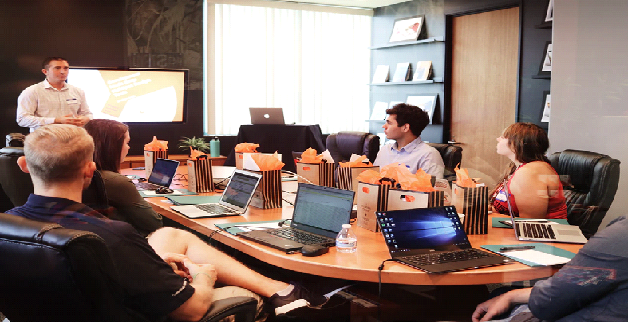
Countless businesses across the globe face the daily struggle of trying to keep high flying talented individuals in their organisations. It was recently reported that an estimated 70% of HR leaders experience difficulty in retaining talent. This does not bode well, especially as these high performers are estimated to be 400% more productive than the average, unmotivated worker. Yet, with the famously coined “war for talent” ongoing, it’s very much an employees job market, without the correct engagement and development, talented individuals will find themselves looking elsewhere whilst their current employers lie idle.This has resulted in a recent wave of HR departments actively implementing retention tactics and internal talent pipelines, to keep their best talent in-house.
Internal people development is a crucial element which enables an organisation to achieve its goals. The challenge for leaders is to create learning and development opportunities that work in the context of their organisation, allowing individuals to flourish. As the working environment becomes evermore complex and greater agility is needed to ensure employees' capability, it is now vital to consider the breadth of different learning methods available and deliver them successfully.
A talent pipeline is an internal pool of candidates that have been identified within a business who may be ready to fill future roles throughout the company. These pipelines specifically match internal prospective candidates with forthcoming roles. Unlike traditional staffing strategies, an internal talent pipeline aims to fill the projected roles from within the business. As a result, employees are more likely to remain within the organisation, driving further business growth and a reduction in recruitment costs.
Developing a successful talent pipeline requires a company to change from reactive to proactive recruiting, something we’re rather excited about here at Green Recruitment Solutions. Businesses no longer have to think about filling vacant roles, rather, they must start considering who they want in the future. This stance has been reflected across the HR industry, with a recent report highlighting that 82% of recruiters see proactive recruiting as a major priority.
Become a people company
It comes with little surprise that successful fast-growth companies are often the best at keeping top talent. It’s also a fact that they are more likely to be considered ‘People Companies’. These are organisations that understand how vital their workforce is to business growth, and especially the advantage of acquiring and retaining talented individuals. These People Companies have shifted from traditional HR processes, for a more unorthodox ‘People’ focussed stance. Often, they’ve automated many internal HR processes to focus on what really matters: their people and building a great environment for them. As expert recruiters within the green industries, we have identified the following two key tips to help businesses build a successful internal talent pipeline.
Recruit based on business strategy
To build an effective talent pipeline it’s crucial that HR leaders have an absolute understanding of the company’s strategic direction overall - This applies for both current needs and future growth plans. Before a recruitment plan can be created, these HR departments must understand which roles are critical to reaching business goals, and gain maximum visibility on future expansion / growth plans. From this point onwards, you must analyse the future needs of the business and the key roles that will need filling in order to reach these goals. This will be invaluable in helping you prioritise where to focus your recruitment efforts.
Simultaneously, you must incorporate a ‘what if’ analysis to determine the outcome if key team members were to leave. This will reveal any potential gaps within your business’ current talent pipeline. Finally, a business must use performance metrics to understand and measure the success of its current talent pipeline plans, and eventually identify areas of improvement. These can include turnover rate by department, open vs. filled roles and offer-to-acceptance ratio etc.
Focus on talent development
Building a successful talent pipeline model goes beyond just finding the right people. More importantly, it’s about the continual development of your internal teams and candidates, which will put both the business and individual in the best position possible for success. After you’ve identified your business’ key assessment criteria, you can start building dedicated programs which address skill gaps and provide ongoing training opportunities for development. This should include both internal and external coaching, as well as internal assignment opportunities - nationally and globally.
If implemented correctly, businesses can have a variety of tactics, leadership development programs and executive training schemes, to name but a few. To be successful, you must ensure you develop a brand and identity for your program, and properly communicate its benefits throughout your organisation for maximum awareness. These internal programs will also serve as a great selling tools to attract future talent into your business.
Maintaining a strong and successful talent pipeline requires not only time and effort, but consistent proactivity from the business and HR leaders. However, the quality of candidates, cost / time-savings will far outweigh the effort of nurturing this internal talent pipeline. The challenge is for businesses to build themselves to be the employer of choice, which will have the candidates just queueing up for opportunities.
Here at Green Recruitment Solutions, our recruitment processes and strategies take a proactive approach, aimed at helping businesses build and maintain strong talent pipelines. We can help you to onboard top talent, achieve quicker turnarounds and reduce costs. For more information on how we can help, please contact Irfan Lohiya on:
T: +44 121 285 6070
M: +44 7580 170 406
E: ilohiya@greenrs.co.uk
W: greenrs.co.uk

